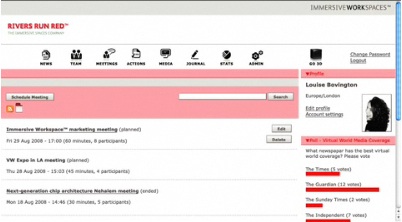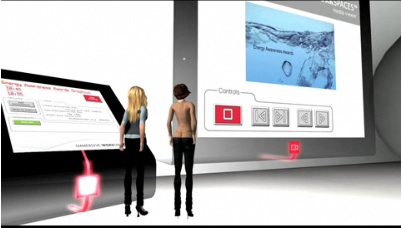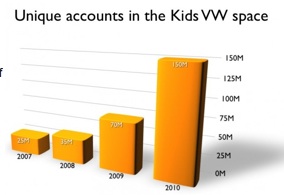1. Centre Daily Times (USA) – Virtual worlds provide real interaction. “When I was a boy, I loved the Tom Swift books. Whether Tom was plumbing the depths of the sea in his Jetmarine or flying into space on his Rocket Ship, technology and quick thinking always managed to save the day. Those books delightfully immersed young readers in exciting worlds of imagination and possibility. Books have long served as “immersion technologies†that transport people to alternate worlds. Today, computer technology takes immersion several steps further.”
2. GigaOM (USA) – Virtual World Marketing That Works: My Top 3 Tips. “So last year, most people decided that marketing real products in virtual worlds like Second Life doesn’t work. Since then, however, I’ve come across some avatar-driven advertising campaigns with very impressive numbers. In Gaia Online, for example, users grabbed over a million virtual copies of a Toyota Scion; in Second Life, a promotion for the IMAX screening of the latest “Harry Potter†movie was credited for boosting the movie’s ticket sales online.”
3. Orange County Register (USA) – UCI tackles ‘World of Warcraft’ mystery. “The National Science Foundation has given UC Irvine $100,000 to figure out why Americans go to greater lengths than the Chinese to modify “World of Warcraft,†the hugely popular multiplayer online game produced by Blizzard Entertainment of Irvine. About 5 million Chinese play “WoW,†which is twice the number of American players. But Americans produce far more modifications, or “mods,†to enrich the gaming experience.”
4. VentureBeat (USA) – Robotgalaxy raises $5M to launch virtual world. “Robotgalaxy, a retailer that lets kids build toy robots, is developing a virtual world where players can take those robots on science fiction adventures. The New York-based company has raised a second funding round of more than $5 million to launch the game, as well as for other expansion.”
5. AsiaOne (Singapore) – Chat, shop and play in virtual S’pore by year-end. “Local Internet users and their life-like 3D digital avatars can soon sip virtual cuppas in virtual Shenton Way cafes. What’s more, they will also be able to chat, work and play in other true-to-life, online 3D cityscapes of Singapore.
This virtual world that looks and feels like Singapore is the brain child of German firm Metaversum. Virtual Singapore, which will be based on a Metaversum platform called Twinity, will be rolled out by year-end, a senior company official told BizIT this week.”
6. The Canberra Times (Australia) – Real interest in Canberrans’ virtual worlds. “Canberra software company Simmersion says its new 3D program Mycosm could rival YouTube with 30million users.
Two years ago chief executive Bob Quodling told his creative team to come up with something that would ”blow the world”. At the Virtual World Expo in Los Angeles two weeks ago, multi-national software companies said his team had done just that. Mycosm, a 3D version of Facebook, allows users to build their own worlds and share them online to play games, exchange media, make money and socialise with friends.”
7. InformationWeek (USA) – Second Life Tries For A Second Act. “I first joined Second Life in January 2007, near the peak of the hype cycle. Second Life was supposedly the next technology megatrend. It would transform the face of the Internet and make present-day technology obsolete. Then the hype cycle burst. Second Life didn’t change the Internet much. Journalists quit the service en masse to follow the next big trend. But I didn’t leave Second Life. I stuck around. I cut back my professional involvement to an article or blog every few months. But I still spend a few hours a week in Second Life, just playing and keeping in touch with friends.”
8. Sydney Morning Herald (Australia) – Exit reality with 3D web browser. “A total internet revolution is here. That’s according to ExitReality founder Danny Stefanic, who launched his 3D web browser software at Melbourne’s Federation Square today. ExitReality purports to be for 3D internet what Google was for web searches, what You Tube was for video and what MySpace and Facebook were for social networking. Available for free at www.exitreality.com as a four megabyte download, ExitReality operates as a plug-in for existing web browsers. The developers say it was designed with the average computer in mind.”
9. Ars Technica (USA) – Hands on: ExitReality, another useless 3D Internet tool. “Yep, it’s that time again kids. Gather round and hear the story of yet another “we’re giving you the Internet—but in 3D!” product. ExitReality (get it?) is a company based in Melbourne, Australia that apparently isn’t very happy with browsing, searching, and socializing on the web in its current state. Thursday, it released a plug-in named after itself that “allows anyone to view every web page in 3D.” Its ExitReality plug-in is built for IE and Firefox on Windows (though you won’t find any of those details on its barren download page), and also offers 3D search, chat with other users, customizable avatars, social networking, and virtual recreations of real-world destinations.”
10. Silicon.com – Naked CIO: Virtual worlds will disappear. “At a recent golfing outing I found myself paired with a software salesman from a company that develops ‘virtual worlds’. I then reviewed silicon.com to find a CIO Jury, which discussed social networking possibilities within the IT field. Not long ago I also read an article about the CIA developing a social networking virtual world program to allow its employees to share intelligence information in a more proactive fashion.”





Recent Comments